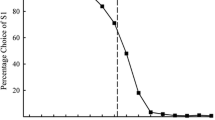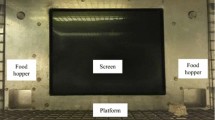Abstract
Repeated acquisition and discrimination reversal tasks are often used to examine behavioral relations of, respectively, learning and cognitive flexibility. Surprisingly, despite their frequent use in cognitive neuroscience and behavioral pharmacology, variables that control performance under these two tasks have not been widely studied. The present studies were conducted to directly investigate the controlling variables in nonhuman primates. Squirrel monkeys were trained with a touchscreen variant of the repeated acquisition task in which a novel pair of S+/S− stimuli was presented daily. Subjects learned to discriminate the two stimuli (acquisition) and, subsequently, with the contingencies switched (reversal). Results indicate that rates of both acquisition and reversal learning increased across successive sessions, but that rate of reversal learning remained slower than acquisition learning, i.e., more trials were needed for mastery. Subsequent experiments showed this difference between the rate of learning novel discriminations and reversal was reliable for at least 5 days between acquisition and reversal and notwithstanding the interpolation of additional discriminations. Experimental analysis of the S+/S− elements of the tasks revealed that the difference in the rate of learning could not be attributed to a relatively aversive quality of the S− or to a relatively appetitive quality of the S+, but, rather, to contextual control by the S+/S− stimulus complex. Thus, if either element (S+ or S−) of the stimulus complex was replaced by a novel stimulus, the rate of acquisition approximated that expected with a novel stimulus pair. These results improve our understanding of fundamental features of discrimination acquisition and reversal.




Similar content being viewed by others
References
Bach ME, Simpson EH, Kahn L, Marshall JJ, Kandel ER, Kellendonk C (2008) Transient and selective overexpression of D2 receptors in the striatum causes persistent deficits in conditional associative learning. Proc Natl Acad Sci USA 105:16027–16032
Butter CM (1969) Preservation in extinction and in discrimination reversal tasks following selective frontal ablations in Macaca mulatta. Physiol Behav 4:163–171
Butter CM, Mishkin M, Rosvold HE (1963) Conditioning and extinction of a food-rewarded response after selective ablations of frontal cortex in rhesus monkeys. Exp Neurol 7:65–75
Chudasama Y (2011) Animal models of prefrontal-executive function. Behav Neurosci 125:327–343
Chudasama Y, Robbins TW (2003) Dissociable contributions of the orbitofrontal and infralimbic cortex to Pavlovian autoshaping and discrimination reversal learning: further evidence for the functional heterogeneity of the rodent frontal cortex. J Neurosci 23:8771–8780
Clarke HF, Dalley JW, Crofts HS, Robbins TW, Roberts AC (2004) Cognitive inflexibility after prefrontal serotonin depletion. Science 304:878–880
Clarke HF, Walker SC, Crofts HS, Dalley JW, Robbins TW, Roberts AC (2005) Prefrontal serotonin depletion affects reversal learning but not attentional set shifting. J Neurosci 25:532–538
Clarke HF, Walker SC, Dalley JW, Robbins TW, Roberts AC (2007) Cognitive inflexibility after prefrontal serotonin depletion is behaviorally and neurochemically specific. Cereb Cortex 17:18–27
Clarke HF, Robbins TW, Roberts AC (2008) Lesions of the medial striatum in monkeys produce perseverative impairments during reversal learning similar to those produced by lesions of the orbitofrontal cortex. J Neurosci 28:10972–10982
Easton A (2005) Behavioural flexibility, social learning, and the frontal cortex. In: Easton A, Emery NJ (eds) The cognitive neuroscience of social behavior. Psychology Press, New York, pp 59–80
Fellows LK, Farah MJ (2003) Ventromedial frontal cortex mediates affective shifting in humans: evidence from a reversal learning paradigm. Brain 126:1830–1837
Galizio M, McKinney P, Cerutti DT, Pitts RC (2009) Effects of MDMA methamphetamine and methylphenidate on repeated acquisition and performance in rats. Pharmacol Biochem Behav 94:305–311
Handley GW, Calhoun WH (1978) The effects of methylphenidate on repeated acquisition of serial discrimination reversals. Psychopharmacology 57:115–117
Harlow HF (1949) The formation of learning sets. Psychol Rev 56:51–65
Histed MH, Pasupathy A, Miller EK (2009) Learning substrates in the primate prefrontal cortex and striatum: sustained activity related to successful actions. Neuron 63:244–253
Iversen SD, Mishkin M (1970) Perseverative interference in monkeys following selective lesions of the interior prefrontal convexity. Exp Brain Res 11:376–386
Izquierdo A, Murray EA (2005) Opposing effects of amygdala and orbital prefrontal cortex lesions on the extinction of instrumental responding in macaque monkeys. Eur J Neurosci 22:2341–2346
Jones B, Mishkin M (1972) Limbic lesions and the problem of stimulus-reinforcement associations. Exp Neurol 36:362–377
Kangas BD, Bergman J (2012) A novel touch-sensitive apparatus for behavioral studies in unrestrained squirrel monkeys. J Neurosci Methods 209:331–336
Kehagia AA, Murray GK, Robbins TW (2010) Learning and cognitive flexibility: frontostriatal function and monoaminergic modulation. Curr Opin Neurobiol 20:199–204
Kim J, Ragozzino ME (2005) The involvement of the orbitofrontal cortex in learning under changing task contingencies. Neurobiol Learn Mem 83:125–133
Knowlton BJ, Mangels JA, Squire LR (1996) A neostriatal habit learning system in humans. Science 273:1399–1402
Lee D, Seo H, Jung MW (2012) Neural basis of reinforcement learning and decision making. Annu Rev Neurosci 35:287–308
Mackintosh NJ, McGonigle B, Holgate V, Vanderver V (1968) Factors underlying improvement in serial reversal learning. Can J Psychol 22:85–95
Nakamura-Palacios EM, Winsauer PJ, Moerschbaecher JM (2000) Effects of cannabinoid ligand SR141716A alone or in combination with ∆9-tetrahrdrocannabinol or scopolamine on learning in squirrel monkeys. Behav Pharmacol 11:377–386
National Research Council (2003) Guidelines for the care and use of mammals in neuroscience and behavioral research. National Academies Press, Washington DC
Olvera-Cortés ME, Anguiano-Rodríguez P, López-Vázquez MA, Alfaro JM (2008) Serotonin/dopamine interaction in learning. Prog Brain Res 172:567–602
Porter JN, Olsen AS, Gurnsey K, Dugan BP, Jedema HP, Bradberry CW (2011) Chronic cocaine self-administration in rhesus monkeys: impact on associative learning, cognitive control, and working memory. J Neurosci 31:4926–4934
Rayburn-Reeves RM, Molet M, Zentall TR (2011) Simultaneous discrimination reversal learning in pigeons and humans: anticipatory and perseverative errors. Learn Behav 39:125–137
Rayburn-Reeves RM, Stagner JP, Kirk CR, Zentall TR (2012) Reversal learning in rats (Rattus norvegicus) and pigeons (Columba livia): qualitative differences in behavioral flexibility. J Comp Psychol Mar 19:Epub ahead of print
Roberts AC (2011) The importance of serotonin for orbitofrontal function. Biol Psychiatry 69:1185–1191
Schultz W, Dayan P, Montague PR (1997) A neural substrate of prediction and reward. Science 275:1593–1599
Spinelli S, Pennanen L, Dettling AC, Feldon J, Higgins GA, Pryce CR (2004) Performance of the marmoset monkey on computerized tasks of attention and working memory. Cogn Brain Res 19:123–137
Walker SC, Robbins TW, Roberts AC (2009) Differential contributions of dopamine and serotonin to orbitofrontal cortex function in the marmoset. Cereb Cortex 19:889–898
Warren JM (1965) Primate learning in comparative perspective. In: Schrier AM, Harlow HF, Stollnitz F (eds) Behavior of nonhuman primates, vol 1. Academic, New York, pp 249–281
Winsauer PJ, Lambert P, Moerschbaecher JM (1999) Cannabinoid ligands and their effects on learning performance in rhesus monkeys. Behav Pharmacol 10:497–511
Zürcher NR, Rodriguez JS, Jenkins SL, Keenan K, Bartlett TQ, McDonald TJ et al (2010) Performance of juvenile baboons on neuropsychological tests assessing associative learning, motivation and attention. J Neurosci Methods 188:219–225
Acknowledgments
The authors thank Rachel N. Cassidy for helpful suggestions, Rajeev I. Desai for comments on a previous version of this manuscript, and Michael Z. Leonard for assistance conducting this study. This research was supported by grants K01-DA035974 (B.D.K.) and R37-DA023142 (J.B.) from the National Institute on Drug Abuse.
Author information
Authors and Affiliations
Corresponding author
Rights and permissions
About this article
Cite this article
Kangas, B.D., Bergman, J. Repeated acquisition and discrimination reversal in the squirrel monkey (Saimiri sciureus). Anim Cogn 17, 221–228 (2014). https://doi.org/10.1007/s10071-013-0654-7
Received:
Revised:
Accepted:
Published:
Issue Date:
DOI: https://doi.org/10.1007/s10071-013-0654-7




